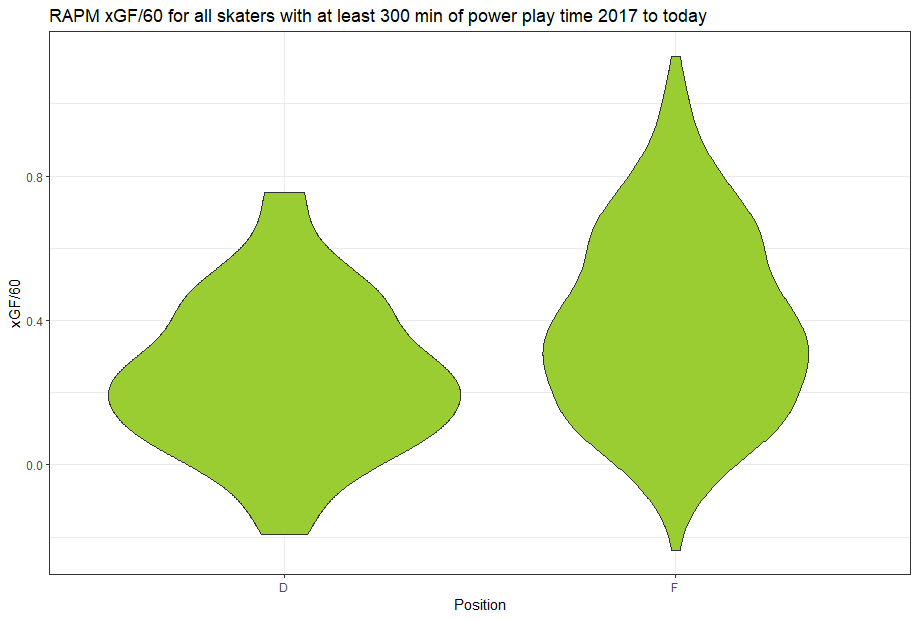The Maple Leafs have been running their first power play unit with five forwards in a couple of practices, and everyone is abuzz about this. They actually have tried it long before now at least once for a short period of time, but it wasn’t noticed by many people. They used it for large chunks of two power plays against the Capitals.
We aren’t all that far away from the days when every team always used two defenders and three forwards on a power play, and some teams still do. The Leafs often do on the second unit, likely because there are times Timothy Liljegren is a better shooting option than available forwards, but it’s rare to see a team use two defenders on the top unit.
So why not go all the way and get rid of the other defenceman too?
The case for needing a defender on the power play amounts to a few things:
- because that’s the way we’ve always done it
- you need at least one to defend rush chances against
- your top power play defender is a better offensive player than your fifth best forward
- defenders are better passers
Some of that is player and team specific, but is likely true some of the time. But the case for just using five forwards is almost entirely acceptance that point two is the price you pay for more goals for. Essentially, the idea is that your defender does not pass better, and you’ve got forwards hustling back to defend a rush against anyway, so that one actual defenceman isn’t going to make enough of a difference to offset the better chance of scoring if he’s watching from the bench. This is extremely true if a team’s defender isn’t a very fast skater.
If you’re willing to risk defending without a defenceman, then the entire question comes down to number three. And number three appears to be generally false as well as false in many specific cases. It’s almost certainly false on the Leafs when Morgan Rielly is on LTIR.
The five players the Leafs use are
- Auston Matthews
- John Tavares
- William Nylander
- Michael Bunting
- Mitch Marner
Anyone who would seriously question this unit’s offensive skill vs any healthy Maple Leafs defender needs to watch a few more games, so there isn’t to my mind any doubt that point three is true for the Leafs right now. But in general?
Back in early December Hockeyviz posted a long piece of research on ageing. It’s well worth a read, and deep into the charts showing various ageing curves is one for the power play split out by position. It shows a fairly dramatic difference in the impact of forwards vs defenders on power play shot generation. It’s not about that per se, so to avoid confusion, I decided to just look at something like that and forget the heavy math on ageing.
Using Evolving Hockey’s RAPM data, I took all skaters since 2017 who have at least 300 minutes of power play time. The total is 350 players, and the range of skill runs from Josh Leivo at just over 300 minutes to Alex Ovechkin at 1,748. John Carlson is second in TOI over this period for reasons that should be obvious.
RAPM is explained in full by Evolving Hockey, but in brief it is “a method for evaluating skater performance that seeks to improve on the known issues with on-ice metrics (such as raw on-ice Corsi For %, etc.).”
What we want to know is exactly what impact defenders have on power play goals vs forwards. Not how many do they personally score, but how much do they contribute. This isn’t a perfect answer, and the extent to which analysis based on public NHL data might undercount the impact of passing on the ultimate shot taken is unknown. RAPM has that weakness for the forwards and the defenders, of course.
RAPM xGF/60
| POS | Mean xGF/60 | Median xGF/60 |
|---|---|---|
| D | 0.25 | 0.23 |
| F | 0.38 | 0.35 |
To see the distribution of these two sets of players at this one skill, a violin plot seemed helpful here:

2017 was chosen because that’s the season when dramatic changes in shot rates began in the NHL. It’s also about when most teams dropped to four forwards and one defender on the first power play unit. It’s a fairly cohesive set of minutes played in the current modern style where the big booming point shot has died through lack of production.
The great bulk of the defenders are very tight to the average performance, and they naturally can’t touch the elite level forwards. There’s a lot more of them who are actively bad as well. Most NHL teams should be able to come up with five forwards better at the power play itself than a unit that includes a defender. But that might really weaken their second unit, and most teams won’t play one unit for nearly two minutes every time like the Capitals do.
You can’t say the 5F formation is absolutely good or bad in the same way you can for the 4F 1D configuration. Carolina and San Jose play a 4F 1D top unit with Brent Burns and Erik Karlsson respectively — people often accused of not really being defenders. No team really should be using two defenders on their top unit.
If dropping the first defender was clearly almost always correct, this 5F scheme is very situationally dependant. And one of the things making it seem attractive to the Leafs is almost certainly lack of footspeed in their healthy defenders. If you’re sending Marner and Nylander back to defend a rush, with Bunting and Matthews chugging a bit slower behind them, you have a better chance of a happy outcome than if Mark Giordano is out there. Rasmus Sandin isn’t slow, but he’s not Marner either. The Leafs don’t need a defender for the setup either because, when you dial 1-800-zone-entry, it’s Nylander who answers.
Running 5F all the time, game in - game out, might require more practice so everyone knows their role when they lose possession, but just because it unravelled a bit in its first outings doesn’t mean the Leafs won’t keep working on it. Much like the triangle PK and the aggressive switch to offence, the risk and the reward have to be measured in the real world for a while before you can be sure it’s a good idea. But other teams have tried the 5F power play, and it seems like only a matter of time before some team just goes for it all the time.


Comment Markdown
Inline Styles
Bold: **Text**
Italics: *Text*
Both: ***Text***
Strikethrough: ~~Text~~
Code: `Text` used as sarcasm font at PPP
Spoiler: !!Text!!